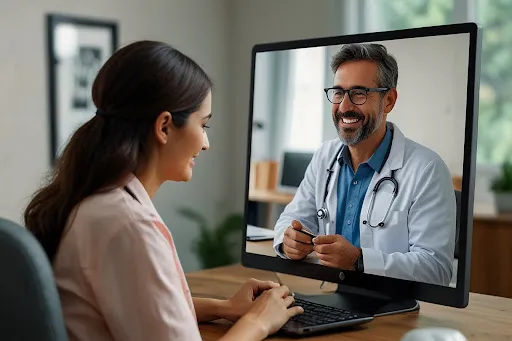Last Updated on –
How Digital Transformation is Changing Healthcare Today

1. Introduction to Digital Transformation in Healthcare
A. Definition and Importance of Digital Transformation
Digital transformation in healthcare refers to the integration of digital technology into all aspects of healthcare delivery. This shift aims to enhance patient care, improve service efficiency, and provide better health outcomes. With technology continually advancing, digital transformation is crucial as it allows healthcare providers to offer personalized, timely, and efficient care to patients in a rapidly changing environment.
B. Historical Context: The Evolution of Healthcare Technology
Looking back, healthcare technology has evolved from paper records and face-to-face consultations to digital platforms and telemedicine. In the past, patient information was often scattered, leading to inefficiencies and errors. The introduction of electronic health records (EHRs) in the early 2000s marked a significant turning point, as healthcare providers began adopting digital solutions to store and manage patient data. Today, we see even more sophisticated technologies such as AI and mobile health apps shaping how care is delivered.
C. Current Trends in Digital Transformation Initiatives
Currently, healthcare organizations are focusing on several key initiatives like telehealth services, mobile health applications, and patient engagement tools. These trends not only improve patient access to healthcare but also facilitate communication between patients and providers. As a result, organizations can provide better health outcomes while fostering a more productive and collaborative environment.

2. Enhancing Patient Experience through Technology
A. Telemedicine: Bridging the Gap Between Patients and Providers
Telemedicine has revolutionized how patients receive care. With just a few clicks, patients can schedule virtual appointments and consult their providers from the comfort of their homes. This convenience reduces barriers to access, especially for those in rural areas. Personally, I remember a friend of mine who was able to see her doctor for a follow-up consultation without traveling two hours. It is impossible to exaggerate how convenient telemedicine is!
B. Mobile Health Apps: Empowering Patients with Information
Mobile health apps are like smartphones on steroids when it comes to managing health. They give patients access to their health data, medication reminders, and even exercise tracking. These apps empower patients to take charge of their health, making informed decisions about their lifestyle choices. It’s exciting to see how technology is giving us more control over our health.
C. Patient Portals: Streamlining Access to Medical Records
Patient portals allow individuals to view their medical records online, schedule appointments, and communicate directly with their healthcare providers. This not only makes it easier for patients to manage their health but also improves transparency in the healthcare process. For instance, I have a family member who used their patient portal to easily access their test results and ask questions directly to their doctor without going through the usual hassle.

3. Data Management and Analytics in Healthcare
A. Electronic Health Records (EHRs): Centralizing Patient Data
EHRs are a game-changer in healthcare data management. By centralizing patient data, healthcare providers can access a complete history for each patient, which improves accuracy and coordination of care. Imagine a scenario where your doctor can simply pull up your entire medical history during a visit—this can lead to better decisions and improved health outcomes.
B. Predictive Analytics: Anticipating Patient Needs and Outcomes
C. Data Privacy and Security: Balancing Accessibility with Protection
While technology offers accessible data, it also raises significant concerns regarding privacy and security. Patients need assurance that their health data is protected from breaches. Healthcare organizations are increasingly focusing on robust cybersecurity measures to ensure that personal health information remains confidential and secure.

4. Operational Efficiency in Healthcare Delivery
A. Automation of Administrative Tasks: Reducing Administrative Burden
B. Supply Chain Management: Improving Resource Allocation
C. Remote Monitoring: Enhancing Care Transitions and Follow-ups
Remote monitoring devices allow healthcare providers to track patients’ vital signs in real time. This advancement means that patients can be monitored from home, helping to enhance care transitions and providing timely interventions when necessary. For example, seniors with chronic conditions can benefit immensely from this technology, ensuring they stay connected to their healthcare team without frequent hospital visits.

5. Future Prospects of Digital Transformation in Healthcare
A. Artificial Intelligence and Machine Learning: Potential Applications
Artificial intelligence (AI) and machine learning are paving the way for groundbreaking improvements in diagnosis and treatment. These technologies analyze vast amounts of data, helping providers identify patterns, predict outcomes, and personalize care plans. Imagine walking into a clinic where your AI-powered assistant already has insights about your health history prepared before your consultation!
B. Digital Therapeutics: A New Approach to Treatment
C. Challenges and Limitations: Addressing Barriers to Adoption
Despite the exciting prospects, challenges still exist in adopting digital technologies in healthcare. Barriers such as high costs, lack of training, and concerns about data security can hinder progress. Stakeholders must collaborate to address these challenges, ensuring that all healthcare professionals and patients can benefit from digital advancements.
Conclusion
A. Recap of Key Points
In summary, digital transformation is significantly changing healthcare by enhancing patient experiences, improving data management, increasing operational efficiency, and offering promising future solutions.
B. The Potential Long-term Impact of Digital Transformation
As digital transformation continues to unfold, it has the potential to create a more patient-centered approach in healthcare, ultimately improving outcomes for everyone involved.
C. For Healthcare Stakeholders
It’s essential that healthcare stakeholders—providers, technology developers, and policymakers—work together to embrace these changes. The future of healthcare is bright, but it requires collective effort to ensure that technology serves its primary purpose: making healthcare accessible, efficient, and effective for all.
FAQ’S
Digital transformation in healthcare includes the integration of digital technology into all healthcare operations to improve patient care, streamline processes, and enhance access to health information.
Patients benefit from digital transformation through improved access to healthcare services, better communication with providers, and personalized treatment plans based on real-time health data.
The main challenges include high costs, training requirements for staff, resistance to change within organizations, and concerns over data security and privacy.
Envitics Solution Pvt. Ltd. is dedicated to transforming healthcare through innovative digital solutions. Contact Us today to explore how we can help revolutionize your healthcare services!
